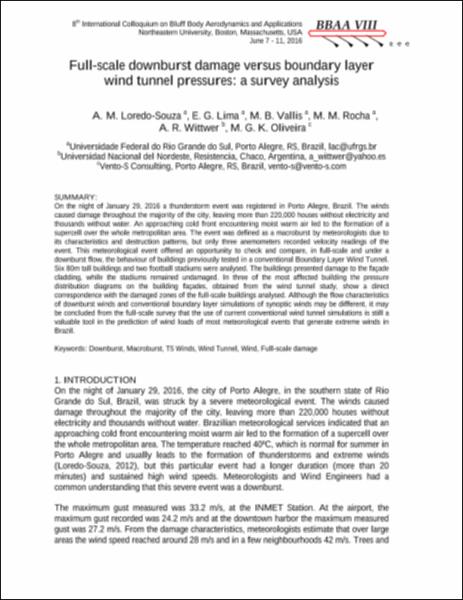Mostrar el registro sencillo del ítem
Full-scale downburst damage versus boundary layer wind tunnel pressures : a survey analysis
| dc.contributor.author | Loredo Souza, Acir Mércio | |
| dc.contributor.author | Lima, Elías G. | |
| dc.contributor.author | Vallis, Matthew B. | |
| dc.contributor.author | Rocha, Marcelo M. | |
| dc.contributor.author | Wittwer, Adrián Roberto | |
| dc.contributor.author | Klaus Oliveira, Mario Gustavo | |
| dc.date.accessioned | 2022-06-07T11:36:26Z | |
| dc.date.available | 2022-06-07T11:36:26Z | |
| dc.date.issued | 2016-06-11 | |
| dc.identifier.citation | Loredo Souza, Acir Mércio, et al., 2016. Full-scale downburst damage versus boundary layer wind tunnel pressures: a survey analysis. En: 8º International Colloquium on Bluff Body Aerodynamics and Applications. Massachusetts: Northeastern University, p. 1-10. | es |
| dc.identifier.uri | http://repositorio.unne.edu.ar/handle/123456789/48040 | |
| dc.description.abstract | On the night of January 29, 2016 a thunderstorm event was registered in Porto Alegre, Brazil. The winds caused damage throughout the majority of the city, leaving more than 220,000 houses without electricity and thousands without water. An approaching cold front encountering moist warm air led to the formation of a supercell over the whole metropolitan area. The event was defined as a macroburst by meteorologists due to its characteristics and destruction patterns, but only three anemometers recorded velocity readings of the event. This meteorological event offered an opportunity to check and compare, in full-scale and under a downburst flow, the behaviour of buildings previously tested in a conventional Boundary Layer Wind Tunnel. Six 80m tall buildings and two football stadiums were analysed. The buildings presented damage to the façade cladding, while the stadiums remained undamaged. In three of the most affected building the pressure distribution diagrams on the building façades, obtained from the wind tunnel study, show a direct correspondence with the damaged zones of the full-scale buildings analysed. Although the flow characteristics of downburst winds and conventional boundary layer simulations of synoptic winds may be different, it may be concluded from the full-scale survey that the use of current conventional wind tunnel simulations is still a valuable tool in the prediction of wind loads of most meteorological events that generate extreme winds in Brazil. | es |
| dc.format | application/pdf | es |
| dc.format.extent | p. 1-10 | es |
| dc.language.iso | eng | es |
| dc.publisher | Northeastern University | es |
| dc.rights | openAccess | es |
| dc.rights.uri | http://creativecommons.org/licenses/by-nc-nd/2.5/ar/ | es |
| dc.subject | Downburst | es |
| dc.subject | Macroburst | es |
| dc.subject | TS Winds | es |
| dc.subject | Wind Tunnel | es |
| dc.subject | Wind | es |
| dc.subject | Full-scale damage | es |
| dc.title | Full-scale downburst damage versus boundary layer wind tunnel pressures : a survey analysis | es |
| dc.type | Documento de conferencia | es |
| unne.affiliation | Fil: Loredo Souza, Acir Mércio. Universidade Federal de Rio Grande do Sul; Brasil. | es |
| unne.affiliation | Fil: Lima, Elías G. Universidad Federal do Rio Grande do Sul; Brasil. | es |
| unne.affiliation | Fil: Vallis, Matthew B. Universidad Federal do Rio Grande do Sul; Brasil. | es |
| unne.affiliation | Fil: Rocha, Marcelo M. Universidad Federal do Rio Grande do Sul; Brasil. | es |
| unne.affiliation | Fil: Wittwer, Adrián Roberto. Universidad Nacional del Nordeste. Facultad de Ingeniería; Argentina. | es |
| unne.affiliation | Fil: Klaus Oliveira, Mario Gustavo. Vento-S Consultoría em Engenharia do Vento; Brasil. | es |
| unne.event.city | Massachusetts | es |
| unne.event.country | Estados Unidos | es |
| unne.event.title | 8º International Colloquium on Bluff Body Aerodynamics and Applications | es |





